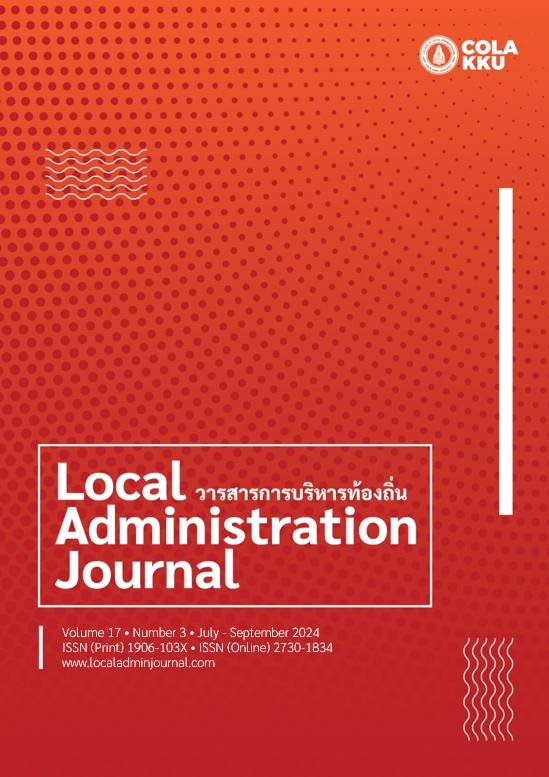Guidelines for Resolving the Cross-Border Haze Problem in Chiang Rai Province through a Chiang Rai-Yunnan “Sister City” Cooperation Framework
Keywords:
transboundary haze, sister city, Chiang Rai-Yunnan, local governmentAbstract
The haze issue in Chiang Rai Province has persisted for several years, exacerbated by both local and transboundary air pollution. Efforts under the ASEAN Agreement on Transboundary Haze Pollution (AATHP) have proven insufficient in adequately addressing the problem. China, particularly Yunnan Province, has been recognized for its effective policies and measures to mitigate transboundary haze. This article aims to investigate China’s policies and strategies—specifically in Yunnan Province—for mitigating haze problems and to provide insights for resolving the transboundary haze issue in Chiang Rai Province. The study emphasizes the use of collaborative frameworks, facilitated through Sister City cooperation, to address haze issues by leveraging existing relationships and favorable geopolitical conditions. The research is conducted using documentary research methods, involving the collection and analysis of relevant documents to draw conclusions. The results indicate that the problem can be addressed through three approaches: 1) promoting knowledge exchange among public sectors and citizens, 2) strengthening Thai-Chinese cooperation to negotiate with Laos and Myanmar, and 3) establishing collaborative frameworks on specific issues, including the consideration of legally binding implementations.
References
Chiang Rai Provincial Government Center. (2022). Policy Brief Report: Preparedness Guidelines and Operational Plans for Developing Sister City Relationships between Chiang Rai Province and Yunnan Province, People's Republic of China, in Trade, Investment, Education, and Cultural Aspects. Chiang Rai: Chiang Rai Provincial Government Center. (in Thai)
Cremer, R. D., Bruin, A. & Dupuis, A. (2001). International Sister-Cities: Bridging the Global-Local Divide. The American Journal of Economics and Sociology, 60(1), 377-401.
Fongissara, N. (2021). The Transboundary Haze Pollution Management in Chiang Rai Province: A Case study of the Single Command Model. Phitsanulok: Naresuan University. (in Thai)
Geo-Informatics and Space Technology Development Agency (Public Organization). (2023). Map showing hotspots on March 23, 2023. Retrieved from https://www.gistda.or.th/news_view.php?n_id=7604&lang=TH (in Thai)
Geo-Informatics and Space Technology Development Agency (Public Organization). (2023). Soaring to the point of concern...!!! Both the heat index and PM 2.5. Retrieved from https://www.gistda.or.th/ewtadmin/ewt/gistda_web/news_view.php?n_id=6845&lang=TH
(in Thai)
GREENNEWS. (2023). Persistent heavy dust, Northern and Northeastern Thailand, 'Severe in Chiang Rai', result from cross-border fires. Retrieved from https://greennews.agency/ (in Thai)
Greenpeace Thailand, GISTNORTH. (2020). Maize, Changes of Land Utilization and Transboundary Haze. Bangkok: Greenpeace Thailand. (in Thai)
Greenpeace Thailand, GISTNORTH. (2021). Forestation, Maize Plantation, and PM2.5 Pollution in Greater Mekong Subregion in 2015-2013. Bangkok: Greenpeace Thailand. (in Thai)
Greenpeace Thailand. (2022). Haze problem in Thai northern region: The issues behind the accusation to farmers. Retrieved from https://www.greenpeace.org/thailand/story /24851/food-agriculture-haze-structural-probleams-behind-discourse-on-burners/
(in Thai)
Greenpeace Thailand. (2022). Not So Amazing, Maize: Mapping 20 years of maize and deforestation in Thailand. Bangkok: Greenpeace Thailand. (in Thai)
Greenpeace Thailand. (2023). Maize: Cross-border Investment and Transboundary Air Pollution. Retrieved from https://www.greenpeace.org/thailand/story/26536/food-agriculture-maize-transboundary-haze/ (in Thai)
Kumtrai, D. (2018). ASEAN Transboundary Haze Pollution and the Resolution of Thai Local Administrative Regulation. CMU Journal of Law and Social Sciences, 11(1), 87-109. (in Thai)
Lhapeerakul, P., Zhai, Y. (2024). An Analysis of Obstacles, Problems, and Sustainable Development Strategies for “City Diplomacy” Operations Between Chiang Rai and Yunnan. Thammasat Review, 27(1), 27-51.
Liu, X., Hu, X. (2018). Are ‘Sister Cities’ from ‘Sister Provinces’?An Exploratory Study of Sister City Relations (SCRs) in China. Networks and Spatial Economics, 18, 473-491.
Mahyuni, S., M. (2021). Sister City Cooperation Model in Wetland Environmental Governance: Case Study in Banjarmasin, South of Kalimantan. International Journal of Politic, Public Policy and Environmental Issues, 1(2), 116-125.
Namkam, T. (2021). The Impact of air pollution on the number of foreign tourists in Chiang Mai and Bangkok. Chiangmai: Chiang Mai University. (in Thai)
People’s Government of Yunnan Province. (2021). Notice from the People's Government of Yunnan Province on Issuing the Fourteenth Five-Year Plan and Vision Targets for 2035 for the National Economic and Social Development of Yunnan Province. Yunnan. (in Chinese)
People’s Government of Yunnan Province. (2021). Notice from the People's Government of Yunnan Province on Issuing the Fourteenth Five-Year Plan and Vision Targets for 2035 for the National Economic and Social Development of Yunnan Province. Yunnan. (in Chinese)
Sister City org. (n.d.). What is a sister city? Retrieved from https://sistercities.org/about-us/what-is-a-sister-city-3
Sretwilai, P. (2021). Get to know about the causes of PM2.5, and why we have always stuck on the rank for several years. thestandagLrd. Retrieved from https://thestandard.co/northern-bush-fire-mystery/ (in Thai)
Sunanta, U. (2022). The Results of policy implementation establishment of Sister-Cities of Chiang Rai Province. (in Thai)
Tsai, T., Hung, M., & Tai, T. (2011). China’s foreign policy in Southeast Asia: Harmonious worldview and its impact on good neighbor diplomacy. Journal of Contemporary Eastern Asia, 10(1), 25-42.
Wei, D., Gu, N., & Liu, Y. (2022). Haze Governance, Local Government Behavior and High-quality Development of Green Economy: Evidence from Chinese Counties. Economic Science, 64-77.
Downloads
Published
How to Cite
Issue
Section
License
Copyright (c) 2024 Local Administration Journal

This work is licensed under a Creative Commons Attribution-NonCommercial-NoDerivatives 4.0 International License.
The copyright of all articles published in the Local Administration Journalis owned by the College of Local Administration, Khon Kaen University.



